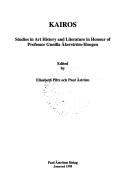| Listing 1 - 10 of 185 | << page >> |
Sort by
|
Book
Year: 1995 Publisher: Ottawa, Canada Institute of Mediaeval Music
Abstract | Keywords | Export | Availability | Bookmark
 Loading...
Loading...Choose an application
- Reference Manager
- EndNote
- RefWorks (Direct export to RefWorks)
Book
Abstract | Keywords | Export | Availability | Bookmark
 Loading...
Loading...Choose an application
- Reference Manager
- EndNote
- RefWorks (Direct export to RefWorks)
Book
Year: 1971 Publisher: [Ivry] : Serg,
Abstract | Keywords | Export | Availability | Bookmark
 Loading...
Loading...Choose an application
- Reference Manager
- EndNote
- RefWorks (Direct export to RefWorks)
Book
ISBN: 9004613692 Year: 1998 Publisher: Leiden : BRILL,
Abstract | Keywords | Export | Availability | Bookmark
 Loading...
Loading...Choose an application
- Reference Manager
- EndNote
- RefWorks (Direct export to RefWorks)
This volume contains nearly twenty essays on obscenity in medieval culture. These essays represent the most wide-ranging attempt ever to probe the natures, origins, and consequences of obscenity in medieval literature, art, theater, and law. Although a core is devoted to obscenity in medieval French literature (where the fabliaux have elicited more previous attempts to come to terms with obscenity than has any other type of medieval literature), other contributions to the volume explore manifestations of obscenity in cultures and languages of Scandinavia, Germany, Ireland, Wales, Byzantium, and even western Slavdom. The book is divided into six different sections: Introducing Obscenity; The Rhetoric of Obscenity; Visualizing Obscenity; Performing Obscenity; Legal Obscenity; and Courting Obscenity in Old French.

ISBN: 9170811806 9789170811807 Year: 1998 Volume: 147 Publisher: Jonsered Åström
Abstract | Keywords | Export | Availability | Bookmark
 Loading...
Loading...Choose an application
- Reference Manager
- EndNote
- RefWorks (Direct export to RefWorks)
Arts, Medieval --- History and criticism --- Arts, Medieval - History and criticism
Book
ISBN: 081090361X 9780810903616 Year: 1975 Publisher: New York Abrams
Abstract | Keywords | Export | Availability | Bookmark
 Loading...
Loading...Choose an application
- Reference Manager
- EndNote
- RefWorks (Direct export to RefWorks)
Art, Medieval. --- Arts, Medieval --- History.
Book
Year: 1977 Publisher: Moskva : Iskusstvo,
Abstract | Keywords | Export | Availability | Bookmark
 Loading...
Loading...Choose an application
- Reference Manager
- EndNote
- RefWorks (Direct export to RefWorks)
Book
Year: 2006 Publisher: Princeton (N.J.) : Princeton university press,
Abstract | Keywords | Export | Availability | Bookmark
 Loading...
Loading...Choose an application
- Reference Manager
- EndNote
- RefWorks (Direct export to RefWorks)
A winged centaur with the spotted body of a leopard playing a lute; a naked man with an animal head; a goat-footed Pan; a four-bodied lion; sphinxes; and hippocamps. Few would associate these forms of art with the Byzantine era, a period dominated by religious art. However, an art of strikingly secular expression was not only common to Byzantine culture, but also key to defining it. In 'Other Icons', Eunice Dauterman Maguire and Henry Maguire offer the first comprehensive view of this "unofficial" Byzantine art, demonstrating the role it played and its dialogue with traditional Christian Byzantine art. This beautifully illustrated book creates an entirely new understanding of the whole of Byzantine art and culture. With its wide-ranging examples, the book vividly demonstrates how the surprise of this "profane" art is not only in its subjects of mythic creatures, exotic imagery, and eroticism, but also in the ubiquity and beauty of their placement--within churches and without, woven into silk, illuminated on manuscripts, engraved into pottery, painted in frescoes, and taking life in marble, bone, and ivory. By presenting and exploring this profane art for the first time in a scholarly book in English, Other Icons will change the way we look at the art of an entire era.
Book
Year: 1980 Publisher: Schwerin : Das Museum,
Abstract | Keywords | Export | Availability | Bookmark
 Loading...
Loading...Choose an application
- Reference Manager
- EndNote
- RefWorks (Direct export to RefWorks)
Book
Year: 1979 Publisher: [Bruxelles : Crédit communal de Belgique,
Abstract | Keywords | Export | Availability | Bookmark
 Loading...
Loading...Choose an application
- Reference Manager
- EndNote
- RefWorks (Direct export to RefWorks)
| Listing 1 - 10 of 185 | << page >> |
Sort by
|

 Search
Search Feedback
Feedback About UniCat
About UniCat  Help
Help News
News